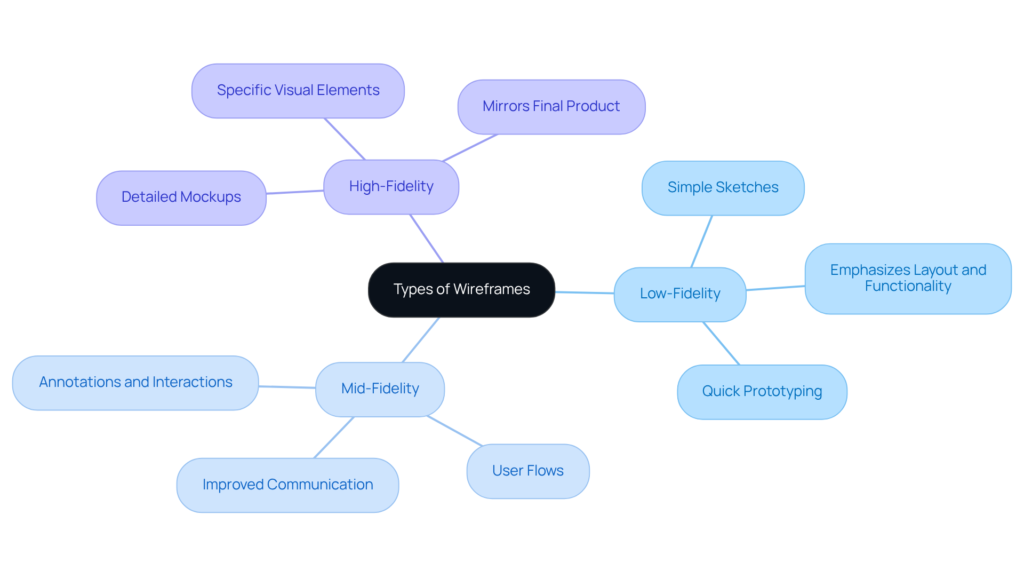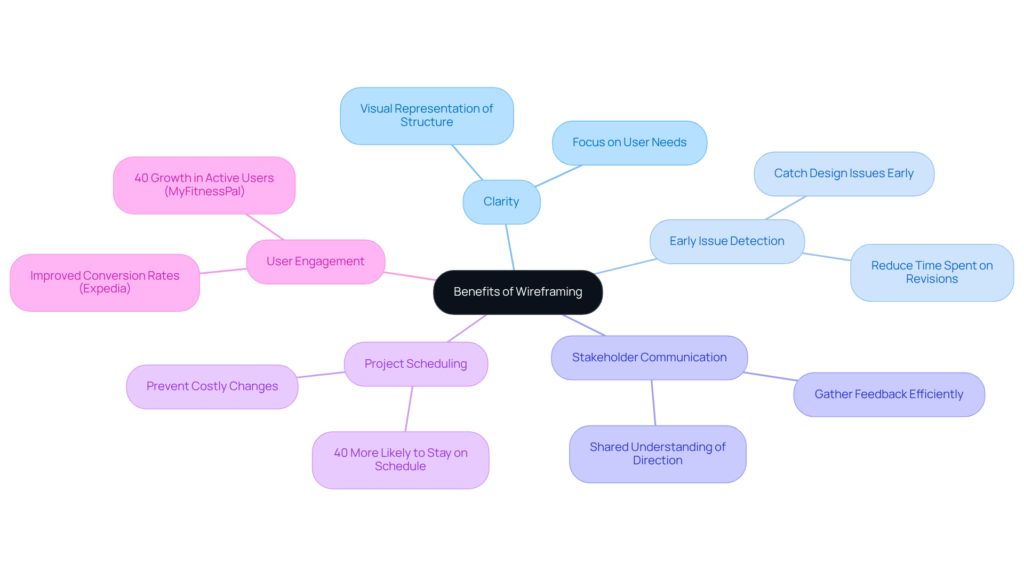Wireframe UX serves as the backbone of digital design, establishing the critical structure and functionality of websites and applications. By visualising the interface prior to delving into intricate design elements, wireframing not only clarifies user flows but also promotes collaboration among stakeholders, ultimately enhancing the user experience. As the demand for intuitive digital interactions escalates, teams must consider:
- How can they effectively leverage wireframing to meet user expectations?
- How can they avert costly missteps in the design process?
1. Wireframe UX: Understanding Its Core Concept
What is wireframe UX? It serves as the foundational framework of digital products, including websites and applications, clearly delineating their structure and functionality. This visual guide illustrates the layout of elements on a page such as headers, buttons, and content areas, while intentionally omitting specifics like colours or typography. In the early stages of the creation process, what is wireframe ux is indispensable; it enables teams to visualise the interface and user experience prior to delving into more intricate components. By providing a clear depiction of the layout, design sketches foster a shared understanding among stakeholders regarding functionality and design direction.
As we progress into 2025, the significance of layout designs in software development continues to escalate. They facilitate early audience testing and feedback collection, ultimately yielding offerings that are more attuned to customer needs. Successful implementations of what is wireframe ux can be seen across various digital platforms, where initial wireframes evolve into intuitive interfaces that significantly enhance user engagement and satisfaction. Notably, businesses that prioritise wireframing often report improved task completion rates and reduced bounce rates, underscoring the effectiveness of this methodology in creating user-friendly layouts. By dedicating time to wireframing, organisations can circumvent costly redesigns and ensure that their final products resonate with audience expectations and requirements.
2. Wireframes in UX Design: Importance and Role
In the UX creation process, what is wireframe ux serves as a cornerstone, effectively bridging the gap between initial concepts and the final product. They empower designers to outline user flows, define information architecture, and establish content hierarchy. By providing a clear visual depiction of layout, prototypes enable teams to identify potential usability issues early in the creation phase, significantly reducing the risk of costly revisions later on. This proactive strategy is underscored by the fact that projects employing visual layouts are 40% more likely to remain on track. Furthermore, 60% of designers utilise layout sketches regularly, underscoring their prevalence and significance in the design process.
Prototypes also enhance collaboration among designers, developers, and stakeholders, ensuring consensus on the product’s functionality and user experience. For instance, the healthcare application MyFitnessPal experienced a 40% increase in active participants after implementing design structures, showcasing their effectiveness in enhancing interactions. Similarly, Dropbox’s onboarding overhaul, guided by preliminary sketches, resulted in a 25% rise in retention rates, demonstrating how sketches can streamline processes and boost overall engagement.
Research on end-users is crucial in this context, as it aids teams in understanding pain points and behaviours, ensuring that prototypes are developed with genuine needs in mind. In essence, what is wireframe ux clarifies creation intentions and cultivates a collaborative environment where feedback can be integrated seamlessly, ultimately leading to a more cohesive and user-centred final product. Moreover, considering accessibility and inclusivity in wireframing is essential for developing solutions that cater to all users, thereby enhancing the overall user experience.
3. Types of Wireframes: Low-Fidelity to High-Fidelity
In UX design, what is wireframe? UX refers to wireframes that serve as indispensable tools, distinguished into three primary categories based on fidelity: low-fidelity, mid-fidelity, and high-fidelity.
- Low-fidelity prototypes represent straightforward sketches that emphasize layout and functionality, often produced swiftly to spark brainstorming and initial discussions. These design layouts empower teams to explore ideas without being bogged down by specifics.
- Conversely, mid-fidelity prototypes introduce greater complexity, incorporating annotations and basic interactions that elucidate user flows and improve communication among stakeholders.
- In contrast, high-fidelity mockups are intricately detailed, closely mirroring the final product by integrating specific visual elements and interactions.
This evolution from low to high fidelity enables teams to iterate effectively, ensuring that each phase of development builds upon its predecessor. Current trends reveal an increasing preference for high-fidelity wireframes in software projects, as they promote enhanced stakeholder engagement and offer a clearer vision of the final outcome. Understanding what is wireframe UX and the distinct characteristics and applications of each wireframe type is crucial for crafting intuitive and user-friendly layouts.
4. Benefits of Wireframing: Enhancing Design Efficiency and Clarity
Wireframing significantly enhances the creation process by offering a multitude of advantages. It delivers a visual representation of a product’s structure, fostering clarity and enabling teams to identify potential issues early. This early detection is crucial, as companies often invest months rectifying inadequate arrangements that could have been addressed with careful planning from the outset.
Furthermore, prototypes facilitate efficient communication among stakeholders, ensuring a shared understanding of the creative direction. This collaborative approach is vital; projects that employ wireframing are 40% more likely to remain on schedule, thereby reducing the risk of costly changes during later development stages.
By promoting rapid iterations and gathering feedback before advancing to detailed development stages, wireframing not only conserves time and resources but also results in a more effective overall creation process. For example, the healthcare app MyFitnessPal experienced a 40% growth in active users following the implementation of wireframes, showcasing the tangible impact of this practice on user engagement and satisfaction.
Additionally, wireframing allowed for swift revisions of concepts for Expedia, significantly boosting conversion rates. Ultimately, wireframing serves as a foundational step that enhances both creation efficiency and clarity, paving the way for successful project outcomes.
5. Best Practices for Effective Wireframing: Tips for Success
To understand what is wireframe ux, creating effective wireframes necessitates adherence to several best practices that enhance clarity and usability. It is crucial to define clear objectives for what is wireframe ux, ensuring that it aligns with the project’s overarching goals. This foundational step sets the direction for the design process. Statistics indicate that 88% of individuals won’t revisit a site with inadequate UX, underscoring the significance of establishing clear goals from the outset.
Simplicity is paramount; focusing on functionality rather than aesthetics helps maintain clarity, allowing users to navigate what is wireframe ux in an intuitive manner. Employing a grid system can further assist in arranging elements, promoting consistency throughout the layout.
Involving stakeholders in the wireframing process is another vital practice. Their initial feedback fosters collaboration and ensures that various viewpoints are considered, ultimately resulting in a more comprehensive outcome. Data shows that stakeholder participation can significantly enhance the efficiency of mockups, aligning the layout with client requirements and business goals.
Ultimately, revising wireframes based on testing and feedback is crucial for refining concepts, which is why understanding what is wireframe ux is essential. As Frosina Stojchevska notes, “UX is not a ‘set and forget’ element; it’s best treated as an ongoing process.” This iterative method not only enhances usability but also ensures that the final product resonates with users. With 53% of users abandoning sites that take longer than three seconds to load, the urgency of refining designs based on user interactions cannot be overstated.
By embracing these best practices, designers can create wireframes that effectively serve their intended purpose and contribute to successful project outcomes.
Conclusion
Wireframe UX is a vital element in the design process, serving as the blueprint for digital products such as websites and applications. By providing a clear visual representation of layout and functionality, wireframes facilitate a shared understanding among stakeholders and enhance collaboration. This foundational tool not only aids in visualising user experience but also significantly reduces the risk of costly revisions later in development.
The role of wireframing in improving design efficiency, fostering early feedback, and guiding the overall user experience cannot be overstated. Wireframes exist in various types—low-fidelity, mid-fidelity, and high-fidelity—each serving distinct purposes throughout the design process. Furthermore, the benefits of wireframing are underscored by statistics that demonstrate increased engagement and satisfaction in applications that effectively utilise this methodology.
Ultimately, embracing wireframing as an integral part of the design process is crucial for creating user-centred products. By adhering to best practises and actively involving stakeholders, designers can ensure that their wireframes not only clarify intentions but also promote a collaborative environment. As the digital landscape evolves, prioritising wireframe UX will remain essential for delivering intuitive and engaging user experiences that cater to the needs of diverse audiences.



